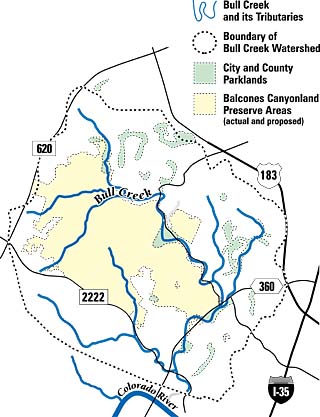Bullish on Protection
By Dan Oko, Fri., June 16, 2000

The Colorado River may stand as one of the last bastions of fresh river water in Central Texas, but one need look no further than the urban creeks and springs that feed the Colorado to understand just what the threats are to Austin's water supply. Like the much-publicized fight to preserve Barton Creek in the face of ongoing development, residents who live in the Bull Creek Watershed, which lies within Research Boulevard, Loop 360, RR 620, and RM 2222, have been raising a hue and cry over the future of this pristine stretch of stream. Bull Creek, in fact, can be seen as a microcosm for what's at stake across the region, while the efforts of the nonprofit Bull Creek Foundation reflect the challenges of preserving and conserving water in Austin.
Skip Cameron, president of the Bull Creek Foundation, explains that, like so much of greater Austin, the area around Bull Creek faces overdevelopment and related issues of degradation. The creek itself, which runs near the limestone cliffs and wooded hills of Forest Ridge past RM 2222, hosts a variety of indigenous species, including the endangered Golden-Cheeked Warbler, and to this day retains an almost primordial character.
"The good news," Cameron says, "is that Bull Creek has really good water quality right now." The bad news is that the corridor where Bull Creek runs, and the associated seeps and streams that make up the 32-square-mile watershed (some of which is within the Balcones Canyonlands Preserve), is threatened by pollution, recreational use, and, most importantly, roadside development along canyons shared by roads and the small river. "We're still searching for some sort of regulatory means to preserve the corridor," Cameron says. "We would like to limit development to more rural-type land use."
Cameron notes that while some of the land, due to its rocky and steep geography, doesn't appear in danger of development, most of the lowlands are not in the public domain. So, unlike Barton Creek and its associated greenbelt, few restrictions exist when it comes to building along Bull Creek, leaving many landowners with a free hand to do what they want. And not only do new expanses of pavement lead to increased non-point source runoff pollution, there's also pollution from construction sites themselves, and later from landscaping projects and lawn fertilizers.
"It may take legislation at the state level to develop an area preservation plan," says Cameron, noting that portions of the watershed remain outside Austin's jurisdiction. "We've been working on this for 10 years now. We've rearranged some development and blocked others, and still watched a whole lot happen." Meanwhile, Cameron vows to continue educating visitors to the watershed, improving trails, pressuring politicians, and cleaning up the mess that has accumulated over decades. During the past four years, he says, the foundation has pulled more than 15 Dumpster loads of garbage from the creek bed, including everything from bottles and cans to car parts and old washing machines.
"It's a constant job," Cameron sighs. "There's been a long, long, long-term trashing of the creek area, and you still see a lot of people who just throw everything out." If the Bull Creek Foundation is successful in its mission, as Cameron hopes, perhaps it can keep Austin from throwing away the creek itself before it's too late.
Got something to say on the subject? Send a letter to the editor.








